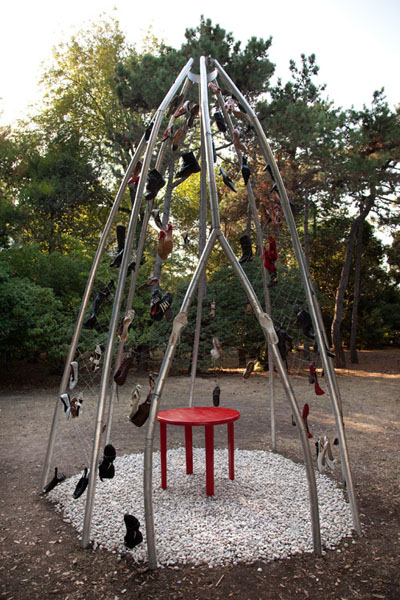FINLAND - KIBA LUMBERG
Ode that gives us wings
Kiba Lumberg’s (b. 1956) Shoe Tower (2009) is an ode that rises up almost to the heavens. It pays homage to all women in the world. To women, who carry the world and the planet in their arms from one generation to the next. “I realise that I carry my mother within me, and I will see her in my dreams for as long as I live,” the artist writes in her latest book Samettiyö (Velvet Night, 2008). At the top of the Shoe Tower is a child’s worn-out shoe. The trajectory of life from childhood to old age is constructed through women’s shoes that tell stories of identities, professions, everyday life, celebrations, human life in all its manifestations. Simultaneously the work pays homage to women’s feet that can also be an object of contempt. Lumberg has in recent years depicted women’s feet also in vivid black-and-white graphic drawings and powerful paintings. Feet are also associated with nomadism, travelling, homelessness as well as the home. The book Velvet Night is dedicated to all people, both living and dead, to sounds and silence, to the sighted and the non-sighted, to those who walk and those who don’t. The dedication is an apt image of the artist’s thinking. Simple, yet so difficult: all people have the right to life, to human dignity. Although Lumberg’s work has resonances both to the life of the individual and to the battlefields of social and world political struggle, it avoids all ideological contention. The soul of Venice is the artist’s muse, both black and white, just like her powerful drawings. Lumberg participated in the first Roma Pavilion at the 2007 Venice Biennale with the work Black Butterfly (2007). This year the Roma Pavilion will not be presented, although human rights violations against the Roma in Italy and elsewhere in Europe are getting worse day by day. “To my great regret I must note that history repeats things, and I am unable to see the Gypsies’ situation good in terms of human rights. Gypsies are outlaws, vagrants, they do not fit in, they are not good enough… How can there still be a people who are forsaken by almost everyone?” the artists wonders. “The Gypsy people are part of world history. All ethnic groups have people who behave well and those who don’t, and conflicts will arise between different cultural communities, even physical conflicts, when people don’t have enough information.” History repeats itself in cruel ways in Venice, Italy, Belgrade, Serbia, Budapest, Hungary… throughout Europe. The way the human dignity of the Roma is being degraded at this very moment should give pause to the hearts and consciences of each and everyone of us. Hiding behind protestations of lack of knowledge is not enough of an excuse for the lack of responsibility. If we lose human dignity and humanity, what is left? “I refuse to submit to the rules of the horde”, Lumberg writes. The priority should be to bring out the human heart in a time of collective and individual fear. We must be able to rise against totalitarianism, even when individual voices, individual steps are being silenced. The responsibility is ours, we cannot hide behind structures. Pictures and words are not deeds, but they can become deeds provided they are shown and said in the right place at the right time, they can move mountains and change the world. Shoe Tower rises up from a red base, reaching up to cosmic spheres. Red, the colour of blood, is a symbol of energy and life. We are born in some place and we come from some place, we reach out to things. The artist’s wish is that the steel-frame tower that stands full four and a half metres tall would connect us to thinking which tells us that we all have our human dignity. Otherwise the world will become an empty, echoing, hollow place. It is obvious that the politics of the neo-liberal finance gave has not carried its responsibility. We are today paying for its yesterday’s consequences. The world was polarised into winners and losers. “If freedom means that you only care for yourself, why do we have society? How far do we have to go before we realise that, instead of greed, inequality and cruelty, we need other solutions? Nature does not need us, we need nature,” the artist claims. The world is ours, nevertheless, and it can be changed, despite its unpredictability. Although we may not be certain of anything today, tomorrow everything can be different. The Shoe Tower gestated for a long time in the artist’s innermost soul. It was not created in isolation, it was thought about and constructed together with colleagues and friends. Thanks are also due to all women who donated their shoes.
Text by Marita Muukkonen
